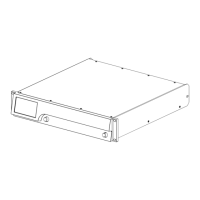
Do you have a question about the d&b audiotechnik D40 and is the answer not in the manual?
| Channels | 4 |
|---|---|
| Amplifier Technology | Class D |
| Analog Inputs | 4 x XLR |
| Digital Audio Networking | Dante |
| Weight | 12.8 kg |
| Signal-to-Noise Ratio | > 100 dB |
| Connectors | XLR |
| Mains Voltage | 100-240 V AC, 50/60 Hz |
| Dimensions (H x W x D) | 88 x 483 x 400 mm |
| Dimensions | 483 x 88 x 400 mm |
Information about document validity and version updates.
Defines graphical symbols used for safety warnings to alert users.
Specifies compatible loudspeaker types and minimum impedance requirements.
Details operating conditions, power supply, protection circuits, and cooling.
Covers analog/digital I/O, network connectors, and their parameters.
Describes DSP functions, touchscreen interface, and physical controls.
Lists power consumption, audio output ratings, noise, and THD+N figures.
Specifies the noise level generated by the cooling fans.
Provides the physical size and weight of the amplifier unit.
Explains the methodology and standards used for audio power output measurements.
Details current consumption, power factor, and thermal dissipation across operating states.
Illustrates and labels all input, output, and network connectors on the rear panel.
Identifies front panel controls like the touchscreen, rotary encoder, and power switch.
Provides instructions for rack installation and maintaining adequate cooling.
Details how to connect the amplifier to the mains power supply.
Describes the analog and digital audio input/output connectors.
Explains the wiring and pin assignments for speaker output connectors.
Details the setup for network connectivity using Ethernet connections.
Describes the function and operation of the front panel on/off rotary switch.
Details the touchscreen display and its interaction with the rotary encoder.
Explains the menu structure and navigation through device and channel setups.
Describes interaction using touchscreen, rotary encoder, and their combinations.
Details how to switch the device to standby mode and its implications.
Explains individual channel mute and master mute functions.
Covers device name editing and input configuration options.
Details input monitoring setup and gain adjustment for each input.
Describes fallback signal path selection and override function for priority.
Explains how to assign output modes like Dual Channel or Mix TOP/SUB.
Details manual and automatic IP address assignment for network control.
Sets the unique remote identifier for the device within a network.
Covers display settings, touch beep, and accessing device information.
Adjusts backlight, brightness, touch beep, and screen timeout.
Enables screen locking and password protection for device access.
Allows editing or assigning a password for device security.
Explains how to unlock the device and perform a factory system reset.
Configures internal buzzer alerts and sets the device's internal clock.
Describes how to clear all device settings back to factory defaults.
Provides firmware versions, serial number, owner, and temperature data.
Displays mute status, speaker setup, input/output levels, and gain reduction.
Limits mains current draw to prevent circuit breaker trips.
Enables automatic switching between normal and low power consumption modes.
Manages device settings presets for different configurations.
Stores and displays system events, errors, and warnings.
Provides a visual map of the channel setup menu structure.
Allows editing the name of individual amplifier channels.
Sets crossover frequencies, listening distance compensation, and array EQ.
Adjusts input sensitivity for amplifier channels.
Provides access to two independent 16-band equalizers for detailed sound shaping.
Displays overall frequency response and provides EQ on/off, edit, and copy/paste.
Allows setting independent signal delay for each channel up to 10000 ms.
Selects signal sources for individual amplifier channels.
Displays meta data from d&b DS devices for digital inputs.
Tools for checking system condition and detecting loudspeaker malfunctions.
Adjusts parameters for monitoring loudspeaker impedance and detecting faults.
Enables selection of loudspeaker setups based on series and model.
Applies array processing data generated by ArrayCalc software.
Electrically compensates for loudspeaker cable properties to maintain tonal balance.
Allows linking EQ and delay settings across channels for unified control.
Provides sine wave or pink noise signals for testing and diagnostics.
Explains how to establish a network connection for remote control via web browser.
Overview of interface tabs: Web Remote, Event Log, Commands, Service.
Details how to change input field values, names, and IP settings remotely.
Covers keyboard input for names/IPs and password dialog for locked devices.
Describes saving and downloading the event log data locally for service.
Provides functions to back up and restore the entire device configuration.
Enables downloading log files for service and troubleshooting purposes.
Details the switch mode power supply, PFC, mains voltage monitoring, and range selection.
Explains how the device reacts to over/undervoltage and mains frequency changes.
Covers generator/UPS requirements and maximum cable lengths for voltage drop.
Describes the use of Class D technology for power amplifiers.
Explains the function of temperature and level controlled cooling fans.
Warning about lithium battery and general servicing guidelines.
Instructions for cleaning the touchscreen using a soft cloth and appropriate spray.
Guides through recalibrating the touchscreen if accuracy issues arise.
Enables screen locking and password protection for device access.
Lists error codes, display text, description, location, and possible reasons.
Lists further error codes, display text, description, location, and possible reasons.
States conformity with directives for the D40 Amplifier.
Provides guidelines for the disposal of electrical and electronic equipment.
Access to open source licenses and copyright information via the web interface.